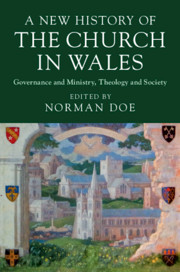Book contents
- Reviews
- A New History of the Church in Wales
- A New History of the Church in Wales
- Copyright page
- Contents
- Plates
- Contributors
- Foreword
- Editorial Preface
- Introduction
- Part I Historical Antecedents and Overview of the Century
- Part II Governance and Ministry
- Part III Doctrine, Liturgy, Rites and Other Faith Communities
- 9 The Doctrine of the Church
- 10 The Liturgy of the Church
- 11 The Rites of Passage
- 12 The Church and Other Communities of Faith
- Part IV The Church and Society
- Part V Conclusions
- Bibliography
- Index
- Plate Section (PDF Only)
10 - The Liturgy of the Church
from Part III - Doctrine, Liturgy, Rites and Other Faith Communities
Published online by Cambridge University Press: 22 February 2020
- Reviews
- A New History of the Church in Wales
- A New History of the Church in Wales
- Copyright page
- Contents
- Plates
- Contributors
- Foreword
- Editorial Preface
- Introduction
- Part I Historical Antecedents and Overview of the Century
- Part II Governance and Ministry
- Part III Doctrine, Liturgy, Rites and Other Faith Communities
- 9 The Doctrine of the Church
- 10 The Liturgy of the Church
- 11 The Rites of Passage
- 12 The Church and Other Communities of Faith
- Part IV The Church and Society
- Part V Conclusions
- Bibliography
- Index
- Plate Section (PDF Only)
Summary
The liturgical history of the Church in Wales since 1920 has been characterised by a movement from uniformity towards diversity in worship. In 1920 the church continued to use the inherited 1662 Book of Common Prayer. After World War Two, liturgical revision was largely conservative - to maintain a single usage. 1984 saw the introduction of a new but again single-use Book of Common Prayer. Today, however, variety is positively encouraged, and technology enables each worshipping community to have its own tailor-made liturgy. As a result, the Prayer Book of the Church in Wales offers at least two different liturgies – a traditional and a contemporary - for each of the major acts of worship of the church; and those acts are supplemented by a multiplicity of further optional texts and ceremonies. This caters for those in both the catholic and evangelical traditions. This can lead to a pick-and-mix approach to liturgy - but this reflects the times, where context is privileged, and worshippers’ needs prioritised. Variety represents a growing realisation that worship does not consist in the words of the text, but in the vibrant interplay of text and action. The congregation is increasingly invited to take part in liturgy, which reflects a shift from passivity to participation in liturgy, as well as from formality to informality in worship.
- Type
- Chapter
- Information
- A New History of the Church in WalesGovernance and Ministry, Theology and Society, pp. 179 - 197Publisher: Cambridge University PressPrint publication year: 2020

